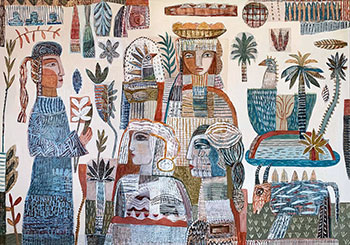
In intricate depictions that defy convention and category, Jill Lewis’s paintings communicate her philosophical and compositional musings. The Melbourne-based artist tells that the title of her exhibition, Life As A Puzzle, is partially an analogy of creative procedure. “The painting process is like a puzzle when dividing the picture plane into areas of colour and tone prior to introducing characters and objects. Imagery of life’s confusions, hopes and dreams has somehow to fit together within certain confines.”
Epitomising the conundrum is the They Went About Their Island Life Imagining the World Was Sane work. “The black and white areas are night and day,” Lewis explains. “Placement was designated for dramatic and compositional purposes. Here night and day are bizarrely happening in one moment. The sun is shining from the darkness of night. Mountains are sitting atop a patch of ocean. Everything in this image is deliberately designed to be puzzle-like and puzzling. Creatures are incomplete yet conjoined. An eel is awkwardly bent into angles so as to contain another patch of sea. Fish move in opposite directions.” Appearing up from the base of the painting a girl practices a ballet pose alongside a palm tree. Lewis imparts that for her, the palm tree has always suggested an idyllic island life and that in this work the inhabitants have found facile contentment by just accepting everything as it is. At the left lower edge is an anthropomorphic bird. Lewis comments that it represents the onlooker, the one who discerns the scene as an unsolved puzzle.
The Peace Offering canvas envisions Lewis’s hopes for an integrated, peaceful world devoid of conflicts and war. She reveals that the imagery was somewhat influenced by her reading about Raine Eisler, an author and scientist who understands life as a system of various systems. According to her and various archaeologists, more than 5,000 years ago human societies had functioned in a caring partnership mode characterised by peace, equity, gender equality and sustainability. “In my mind the transdisciplinary nature of such systems aligns with the idea of Life as a Puzzle,” Lewis relays. To the left of her painting the female figure represents Raine Eisler offering her knowledge to others in the form of a white flower that generally symbolises peace. Lewis comments that the gesture could also be construed as an offering of forgiveness or reconciliation, a demonstration of good will. She explains that the elaborately decorated figures are depicted to suggest timelessness, whilst the birds and plant forms denote environmentally positive outcomes in a peaceful world.
Vibrating with gestural energy and allegorical implications amidst compositional factors, each painting generates visual intrigue. The viewer is inexorably drawn into the puzzles of life that Jill Lewis has discerned and masterfully presented.
JACQUELINE HOUGHTON
Receive e-mail updates on our exhibitions, events and more
Subscribe Now